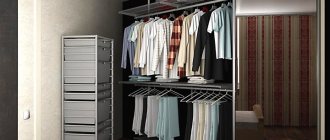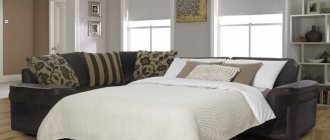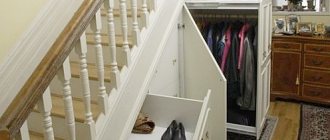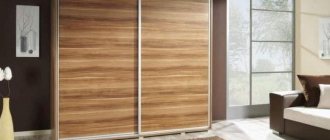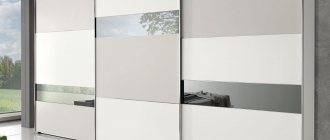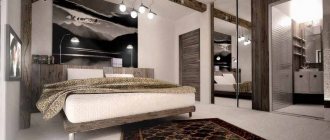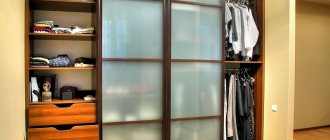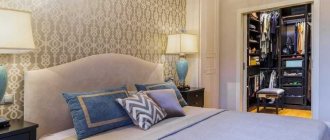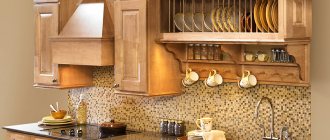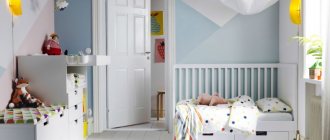Features of a dressing room in the interior
Each dressing room, regardless of its location and design, has its own characteristics:
- All wardrobe items and personal belongings are arranged in strict order.
- If you wish, you can sort things in an original way by color, season and for each family member.
- A distinctive feature of the dressing room is a large number of shelves, racks and hangers.
- All wardrobes are made of a closed type, which protects clothes from moisture, cold, and sunlight.
- Especially for shoes, you can consider lattices or boxes located on the lower tiers.
The main advantages of the practical use of a dressing room are convenience and order in the house.
Kinds
All furniture for the hallway should be as spacious and functional as possible. Drawers, containers or boxes are suitable for small accessories. Everyday items are located with easy access to them. Seasonal clothing is placed on top. High long pencil cases are installed for shoes. Shoes and summer footwear are placed on special hangers. A full-length mirror and a small, comfortable pouf add special comfort and coziness.
Corner
For rectangular corridors with a small area, a corner wardrobe option is ideal. Rational design maximizes the space for the whole family's belongings. The configuration in the hallway is most suitable for small apartments. The modular design implies a capacious storage system:
- Open shelves;
- Pull-out drawers;
- Metal crossbars.
The bulkiness is significantly reduced by the mirror side, visually enlarging the room. A corner multifunctional dressing room is an alternative to a dressing room.
A corner dressing room in light colors with a small mirror will fit perfectly into the space of a small hallway.
In a niche
A wardrobe in a niche is a budget-friendly way to place things without disturbing the unity of the space. It is important to comply with the stylistic design of the house. Doors can be:
- Swing;
- Folding;
- Sliding;
- Pendulum type.
The fabric used is:
- Tree;
- Glass;
- Plastic;
- Laminated surfaces.
Design of a dressing room in a niche.
Glossy, reflective surfaces will help to increase the space in small hallways. The dressing room is usually quite spacious in the niche. Used as a closet and changing area.
Open type
The illusion of a spacious hallway is given by an open-type dressing room. Variation involves the arrangement of all things in the field of view. It is necessary to maintain order. The design of the system consists of metal or wooden dividing walls and fairly spacious shelves. The compartments at the top and bottom are closed with doors.
Open wardrobe in the hallway.
Small items and things are stored in decorative containers and boxes. It is recommended to place a comfortable pouf or small couch along the shoe racks and with things. The dressing room assumes the continuation of the room, so it does not deviate from the unity of style.
Closed
The parameters of a closed dressing room depend on the size of the hallway. In small, narrow hallways, installation of compact options is suitable. In both cases, the main advantages stand out:
- Isolation of things;
- No dust pollution.
Closed wardrobe hidden behind the doors.
The equipped room allows you to do fittings for any occasion. Installing an ordinary mirror will turn the dressing room into a real toilet room. Proper location involves choosing the location, ventilation and lighting system.
Closed wardrobe with mirror.
Drywall
A good option for placing a dressing room in part of the room. Natural material, safe for humans. It is distinguished by its affordable cost and ease of installation.
Note!
Dressing room in the hallway - TOP 170 photo and video options. Layout and choice of location, ideas for filling the interior space
Dressing room in the bedroom - unusual examples, choice of style and secrets of arrangement (170 photo ideas)
Dressing room in an apartment: 175 photos and video examples of how to make a beautiful and practical dressing room
Pros and cons of a corner dressing room
The advantages of a corner dressing room include:
- what you will have will not be a mess;
- the fact that you have the opportunity to use unused space;
- the fact that it is compact will help out owners of one-room apartments and studios;
- the fact that it allows you to hide unsightly communications, walls and part of the ceiling with some defects.
But it would be wrong to give only the advantages of a corner dressing room. Therefore, we will dwell on the disadvantages. They are:
- the fact that some types (they will be discussed below) are suitable only for large and medium-sized rooms;
- the fact that the fitting area is limited;
- the fact that there is no good sound insulation - if one person gets dressed in the morning, the second may wake up.
Wardrobe made of metal pipes
Used to create a mesh wardrobe. The main advantage is the strength of the frame and good ventilation of the room. The disadvantage is that the master must have certain welding skills.
A small but original dressing room can be built from old furniture.
Master class on building a dressing room
For inexperienced craftsmen, there are video tutorials and detailed instructions on how to make a dressing room with your own hands. The entire construction process can be divided into several stages:
- Creating a drawing, counting consumables.
- Frame assembly.
- Door assembly.
- Auxiliary work on communications to the dressing room
Each stage is carried out sequentially, and its plan depends on the chosen model of the dressing room.
Note!
- Ikea wardrobe: pros and cons of Ikea furniture. A variety of models and colors of dressing rooms. Photo and video reviews of the main collections from designers
- Built-in dressing room: pros and cons of a built-in dressing room. Tips for choosing a location. Making doors (photo + video)
- Dressing room project: TOP-160 photos and video reviews of dressing room projects. Varieties of layout and installation, choice of size and content
Where to begin?
Deciding on the workspace. To functionally place everything you need, 1.5-2 square meters is enough. meters. It is possible to allocate such space in a home of any size.
You need to decide exactly where the storage structure will be. It will be a bedroom, a storage room, maybe a corner in the hallway or just part of a room.
Why do you think the prospect of assembling it yourself is better, because there are many specialists who will quickly and efficiently do such work.
This has its advantages, there is nothing to argue with, who knows their own habits better than you, what is the best place to hang and lie. Only self-assembly of the dressing room will help you quickly find everything you need and make the house cleaner.
To prevent the construction process from dragging on for many years, think through everything in advance. There are a lot of options on this topic on the Internet.
Ready-made photos of dressing rooms with your own hands, design projects, diagrams, drawings will become a clear example and will help you navigate further actions.
Check it out here too!
DIY illuminated ceiling: 85 photos of the best options! Types of lighting: spots and features of their connection, LED backlight, diode backlight, “starry sky”Assembling a shower cabin with your own hands: assembling the tray, preparing and installing the walls, installing the portal. All stages of assembly with photos
- How to make ventilation with your own hands - we ensure freshness in the house, create comfort yourself (photo + video)
Create a drawing
At this stage, you need to select a part of the house where the future dressing room will be located. Next, you need to take measurements and transfer the main parameters onto the drawing paper.
The height of the room, width and depth are taken into account. The doorway distance for manufacturing or ordering doors is also calculated.
It is necessary to calculate the amount of materials in advance:
- Wooden blocks, plywood, chipboard sheets.
- Paints and primers for interior decoration.
- Quantity and list of accessories.
It is important to make these calculations in advance so as not to overpay at the hardware store.
Materials
To make the structure you will need some tools and materials for the work. The list is compiled based on the information from the compiled project:
- The frame is created from guides and rack profiles. It is important to consider the thickness of the partitions. Thick ones take up a lot of space, limiting space;
- The partitions are covered with plasterboard up to fifteen millimeters. It is advisable to choose moisture-resistant varieties;
- The frame is filled with soundproofing materials, for example, mineral wool;
- For finishing work: putty, mesh that strengthens the putty layer, finishing in the form of wallpaper, paint or wall panels;
- Lighting devices, sockets, switches, wires for electrical wiring;
- Accessories for storage systems, doors and other possible elements;
- Shelves, racks, mirrors, other filling elements. When choosing, they rely on the layout, individual wishes and financial capabilities.
Frame assembly
Before starting work, surfaces must be pre-treated: walls, floors, and ceilings are coated with a moisture-resistant compound, the surface is primed and painted (optional).
The same actions are carried out with wooden parts to assemble the structure. The frame for shelves and racks is mounted to the underlying wall using fasteners, screws, and metal corners.
Note!
Sliding wardrobe: advantages and disadvantages of sliding door systems. Choosing the right location and size. Photo and video reviews of options
- DIY wardrobe: step-by-step instructions for beginners. Selection of materials and tools for the dressing room. Video reviews + 130 photos
Doors for a dressing room: TOP-180 photos and videos of door options for a dressing room. Varieties of door systems, fastenings and materials of manufacture
One or more central axes for hangers are equipped with a metal pipe. Shelves and racks are mounted on a prepared base, focusing on the drawing.
They assemble a frame for the door panel or order its production from a craftsman.
Arrangement: filling and storage systems
If the area is limited, there is no point in making furniture from wood, MDF or chipboard into the wardrobe. They take up precious centimeters of space and also interfere with air movement. Another disadvantage is that redoing something is problematic.
“Standard” type furniture takes up too much space
Recently, the general trend is the installation of lightweight metal storage systems. They are modular and assembled on special racks. Racks can be attached in two ways - to the walls or to the ceiling and floor: different manufacturers make different systems. And everything that is needed is hung on these racks.
The racks can have notches along the entire length, which makes it possible to install any element at any height. These are the most mobile systems that can be modified quite easily - simply by moving them from one row of notched hooks to another, arbitrarily changing the height of the shelves and baskets, and other elements.
Convenient modular system
There are racks of rectangular cross-section, with grooves cut on both sides. The necessary components are attached to the clamps in these grooves.
Different type of racks and different mounting system
Please note that there are different shelves and drawers - made of wood or wood materials, metal - chrome-plated or painted. They can be retractable, they can be placed one on top of the other or on shelves.
All these systems are sold: racks and a list of various components. But they are produced mainly in European countries, so the price is high. An economical option for dressing room equipment can be made independently from a round chrome-plated furniture pipe and various fasteners for it. It turns out that this furniture is not as mobile as we would like, but it costs significantly less.
Round furniture tube wardrobe equipment
On the shelves you can place plastic containers (boxes) with lids for storing shoes and other things. It is better if the containers are transparent - it will be easier to look for things.
Devices for placing clothes
In addition to standard and not so standard drawers and shelves, there are interesting special options. For example, skirts or trousers. Special guides on which the transverse strips are attached, sometimes they have clips. They allow you to hang your skirts/pants straight and not be afraid that they will fall. It is convenient if such a hanger extends, allowing you to inspect all the contents.
One of the options for filling a dressing room is a bracket for skirts or trousers
This device can be replaced with a simpler one, but much cheaper - a hanger with crossbars located one below the other. It's not as convenient, but it allows you to organize your clothes just as well.
Budget option for hangers for trousers and skirts
There is a retractable design for ties, only it is usually oriented differently and extends out in length, although not everyone likes such a system, but prefers folded drawers into cells.
Tie devices
There are several ways to place hangers. The simplest are pipes, the more economical (in terms of space use, but not in terms of money) are tie-like retractable brackets.
Pull-out brackets for clothes hangers
Another device is a pantograph for clothing. This is also a pipe, but capable of descending. A kind of lift for clothes. This device allows you to use the space right up to the ceiling, without compromising your comfort. It can be attached either to the side walls (the more common option) or to the wall. There is a handle-bar attached in the middle of the pipe, by pulling which you lower it to a horizontal position. The carrying capacity of such devices is usually small (up to 18 kilograms), so they are used for lightweight clothing.
Furniture pantograph - for light (by weight) clothes
Shoe storage systems
Problems often arise with storing shoes: some people have dozens of pairs of them, so it’s time to arrange separate dressing rooms for them. But among the standard sets of equipment there are several interesting ones for storing shoes.
Let's start with the retractable system. IKEA has it. Pins with shoe modules mounted on a movable frame. Convenient, compact.
Retractable shoe system
There are mini chests of drawers that do not take up much space, but are hung on the walls, and there are hanging organizers that can be easily placed on a horizontal pipe.
Shoe storage systems in the dressing room
These are mini chests of drawers on the wall
In general, there are many interesting ideas for shoes that allow you to place them compactly and at the same time conveniently. Some are in the photo gallery.
Wheel for storing shoes
Swivel round cabinet. Great use of corner space
Such “rotating” drawers are very convenient not only for shoes, but also for small items and linen
The way to store boots is on hangers with clothespins
Devices for compact shoe storage
Such systems are mounted on doors or walls
There are very inexpensive options. For example, the seasonal one, which is currently in use, can be stored on a grid with rearrangeable hooks or wire shelves. You've probably seen similar ones in stores. This is a mesh or perforated panel on which hooks/shelves are hung. Convenient: you can move it under any type of block, make the distance larger or smaller.
An economical option for storing shoes - a mesh with hooks and shelves
Hanging such a grid is not a problem - even on a wall, even on the side surface of a cabinet or door. Hooks and shelves simply cling to the crossbars. This option is ideal if you are short on money and space. If you like the idea but need something more presentable, make or find a perforated metal shield on the frame. Hooks are also inserted into it with a bang.
Modification - shield with hooks
In general, when arranging a dressing room and on a limited budget, you should look for storage systems not in furniture stores - online or offline. It’s better to look at sites that sell commercial equipment. There are many interesting devices that save space: stores also try to display the maximum amount of goods in a minimum area. For example, these are shoe racks.
Shoe stands
If you attach wheels to the first one, you get an excellent retractable system. The price of such equipment is much less than similar equipment, which is sold in furniture stores.
Door assembly
The installation of the door panel will depend on the design mechanism. These can be classic doors, rotary mechanisms or sliding panels.
Textiles, thick paper or plywood are used as additional material for door upholstery.
Auxiliary works
No dressing room can optimally perform its functions without lighting and electricity. To do this, at the stage of creating the drawing, the laying of wires and the arrangement of sockets are calculated.
Lastly, hang a lamp or chandelier, place sconces on the walls of the dressing room, and form plugs for sockets (if there are children in the house).
Where to place the dressing room
There are several options for placing a dressing room in an apartment or private house:
- In a storage room or building niche.
- In the bedroom.
- Under the stairs to the second floor.
- In the attic.
- In the hall.
The choice in each specific case depends on the circumstances and various factors (room area, number of family members, financial capabilities of the home owner).
Advantages and disadvantages
The dressing room has a number of advantages:
- Unity - the storage system takes into account the rational arrangement of all planes;
- Conciseness - the use of built-in modules for a small room;
- Cost-effectiveness – the ability to save money through the use of a facade;
- Reconstruction of surfaces – leveling of minor irregularities.
There are also disadvantages:
- Lack of mobility - embedded systems cannot be moved to another location;
- Repair - after completion of dismantling work, cosmetic repairs are made to individual areas or the entire room;
- Complexity of assembly - to arrange the structure, certain knowledge and skills are required.
Design of a dressing room in the hallway.
Dressing room in the pantry
Practical advice from designers on how to make a dressing room in a pantry:
- First of all, it is worth carrying out the interior decoration of the room.
- Place the frame, shelves and hangers.
- Lastly, install the doors.
The best option is dressing rooms with sliding doors.
The option of placing a dressing room in a closet or a construction niche is very convenient - after all, the closed type room is already ready, you just need to put it in proper shape.
Decor
Natural wood is used to create expensive, luxurious wardrobes. For economical options, MDF and chipboard materials are used. Compartment doors are often wooden or made of durable glass. Storage systems in the form of baskets and boxes are usually made of plastic, rattan or wicker.
Storage systems in the form of baskets and drawers are presented here.
Wardrobes in dark shades are suitable for spacious rooms. Bed shades are suitable for small areas. In both cases, the overall design concept of the apartment is taken into account.
Wardrobe in dark colors.
If there is insufficient natural light or its complete absence, it is important to pay attention to artificial lighting. The ceiling chandelier does not provide a full overview of the entire storage system. Illumination of individual zones is required. LED strip and spotlights create soft, diffused light. Proper design organizes the space, creating maximum functionality and comfortable storage.
Lighting in the dressing room.
Dressing room under the stairs
For owners of two-story houses or houses with an attic, it is worth reading the instructions on how to make a small dressing room under the stairs.
This approach will save space and optimally organize the existing niche under the stairs.
Organizing a full-fledged dressing room is not just saving space in the house, but also an aesthetic addition to the interior.
Ventilation and lighting
Even in mini-dressing rooms, and even more so in large ones, ventilation is necessary: in a closed room, a musty smell quickly appears, which no perfume can mask. Therefore, even when planning, find a way to make ventilation in the dressing room.
The principle of its design is no different: in the upper part of any of the walls, preferably further from the door, an exhaust hole is made into which a fan is inserted. The inflow is provided either into the gap under the doors or into special inlet openings located just above the floor level. They are closed with decorative grilles. The outlet of the ventilation duct must be in the general ventilation system; you can use plastic boxes to take it out onto the street or under the roof of a private house. Air exchange organized in this way effectively maintains the normal state of things.
Principles for organizing ventilation of a dressing room through a bathroom
When choosing a fan, you should pay special attention to the noise level. Since dressing rooms are often located in bedrooms or close to them, noise should be minimal. The fan can be controlled automatically or turned on/off using conventional or walk-through switches.
The lighting should be bright. Firstly, this is necessary to quickly find things, and secondly, dressing rooms are often used as fitting rooms to immediately see how well the selected items fit together. The mirror is usually placed on the door or mirrored doors are made. In this case, the light should be directed not only to the shelves and storage systems, but also to the fitting area.
One of the lamp options
You can use lamps of any type, but it makes sense to make them turn on from motion sensors. They opened the doors - the lamps came on, there was no movement, they turned off. There is another option for swing doors: there are lamps with buttons that light up when the door is opened and turn off when they are closed.
